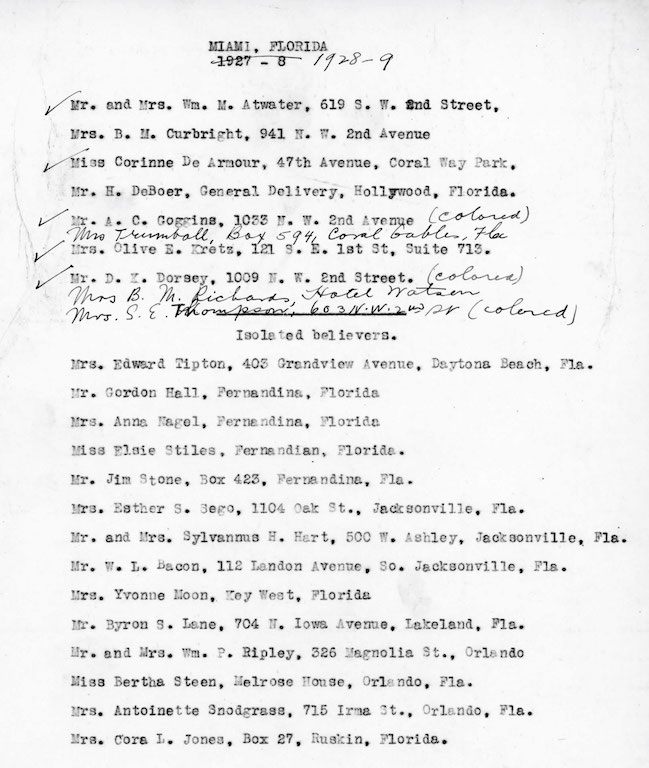The views expressed in our content reflect individual perspectives and do not represent the authoritative views of the Baha'i Faith.
The Baha’i entrepreneur Dana A. Dorsey was an illustrious figure in the history of the black community in segregated Miami during the Jim Crow era.
Mr. Dorsey had an equally illustrious Baha’i friend: Major Goggins, otherwise known as A. C. Goggins or Alfred Christopher Goggins. This gentleman was probably the same “A. C. Goggins” who was a member of the Miami Baha’i community in 1928–1929, and likely in 1927 as well. There is strong evidence for this identification.
Mr. Dorsey’s name and address appear on the 1928–1929 Baha’i Miami Baha’i membership list, indicating that Mr. Dorsey was formally a member of the Baha’i Faith at that time. The list includes three African American Baha’is, noted in those days with the then-respectful term “colored:”
Mr. A. C. Goggins, 1033 N. W. 2nd Avenue (colored)
Mr. D. K. [sic] Dorsey, 1009 N. W. 2nd Street. (colored)
Mrs. S. E. Thompson, 603 N. W. 2nd St (colored)
– National Baha’i Archives, United States, Office of the Secretary, Membership Lists Files, Courtesy of Edward Sevcik, Archivist, May 15, 2018.
Fascinated, I asked Steven Kolins, independent researcher, to see what he could find out about “A. C. Goggins.” Mr Kolins discovered that this was probably none other than “Major Alfred Christopher Goggins,” who was a very illustrious man in his heyday—a distinguished military veteran, an actor and an activist for racial justice.
After reviewing several newspaper articles that Mr Kolins sent me, I came across an article by Stetson Kennedy, “Ex-Slaves Of Miami Organize,” which detailed the 1932-era efforts of Major Goggins, who organized the “Ex-Slave Association of Greater Miami.” Stetson Kennedy described Major Goggins as follows:
Major Goggins, president and guiding spirit of the Ex-Slaves, with his stately form, soldierly carriage, bushy gray hair and flowing beard, has been a familiar and striking figure in Miami for the past 20 years. A veteran of the Civil War, Spanish-American War, and World War, Major Goggins has had a noteworthy and colorful career.
He was born near Columbia, South Carolina, on November 24, 1838. At the age of three, he, his mother and 148 other slaves were put “on the block;” the entire assemblage sold for $1,110. During the Civil War he was sent by the Confederate Army as a spy to Washington, where he was four times questioned by President Abraham Lincoln, but never suspected of being a spy.
He was awarded a scholarship to Amherst College where he received an A.B. degree and the distinction of being Amherst’s first Negro alumnus. In 1878 he joined the army, serving 14 years as First Sergeant of the Black Horse Troop, and as military aide to Miss Rosa Lee Cleveland, sister of President Grover Cleveland. He served in the Spanish-American War, and in 1906 accompanied General W. H. Carter as an orderly and attendant on a world tour. He was honorably discharged from active duty in 1913.
Although Major Goggins was 79 years old at the time the United States entered the World War, he was sent to France as a Brevet-Major and placed in command of 1,000 men unloading munitions at Port Brest. He has since made a name for himself as an actor, having played the part of the Seminole Indian Chieftain in the motion picture “Passion Vine,” made in 1922, and the part of Uncle Jasper in “Suwanee River,” filmed in 1925. In 1936 he portrayed Old Black Joe in the dramatic production of that name. – Stetson Kennedy, “Ex-Slaves Of Miami Organize,” Opportunity: Journal of Negro Life Vol. 17, No. 9 (September, 1939): pp. 271, 287.
Out of eleven adult Baha’is in the Miami Baha’i community during the 1928–1929 Baha’i year, three were described as “colored.” Race is still an identifier to this day—how much more so in the Jim Crow era. Even so, it is good to know that three out of eleven (27%) of the Miami Baha’is were African Americans. Such a proportion might be considered “politically correct” today—but, back in the day of Jim Crow segregation, such a racially integrated community was most definitely frowned upon, and was therefore most definitely politically incorrect.
The early Miami Baha’i community, with its illustrious African American members of D. A. Dorsey and Major Goggins, truly exemplified racial integration as part of the greater Baha’i-inspired social transformation mentioned by the Baha’i International Community on the occasion of May 29, 1992, which marked the centenary of the passing of Baha’u’llah, prophet-founder of the Baha’i Faith:
In more recent years, as the Baha’i community’s numbers have rapidly increased in many countries, the situation has changed dramatically. There is now virtually no area in the world where the pattern of life taught by Baha’u’llah is not taking root. The respect which the community’s social and economic development projects are beginning to win in governmental, academic, and United Nations circles further reinforces the argument for a detached and serious examination of the impulse behind a process of social transformation that is, in critical respects, unique in our world.
No uncertainty surrounds the nature of the generating impulse. Baha’u’llah’s writings cover an enormous range of subjects from social issues such as racial integration, the equality of the sexes, and disarmament, to those questions that affect the innermost life of the human soul. The original texts, many of them in His own hand, the others dictated and affirmed by their author, have been meticulously preserved. For several decades, a systematic program of translation and publication has made selections from Baha’u’llah’s writings accessible to people everywhere, in over eight hundred languages. – Baha’i International Community, “Baha’u’llah,” p. 2.


















Comments
Sign in or create an account
Continue with Facebookor